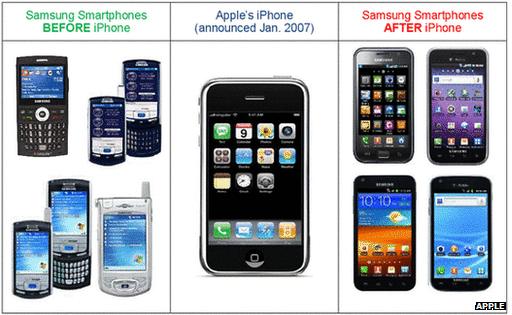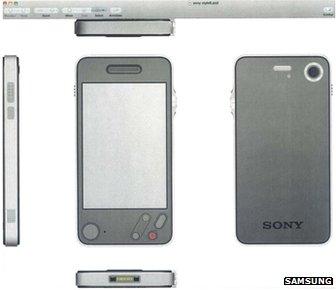Q&A: Apple and Samsung trial
- Published

Apple has said Samsung copied its iPhone design - and the jury agreed
A verdict has been reached - and quite quickly - in the trial between Samsung and Apple - one of the biggest patent battles of its kind.
A US jury said Samsung should pay Apple more than $1bn in damages in an intellectual property row, while rejecting Samsung's claims that several of its patents had been breached and awarded it no damages.
The verdict will have huge ramifications for phones and tablets, not to mention how intellectual property and patents are used by businesses.
What was the trial about?
Together the two companies account for more than half of all the world's smartphone sales.
The tech firms accused each other of intellectual property infringement.
Despite the fact that Apple buys many of its components from Samsung, the two have failed to agree cross-licensing deals even after the courts forced their bosses to meet for talks.
The case was prompted by a lawsuit from Apple in April last year. A countersuit by Samsung followed.
The two actions were combined into one trial, which began less than a month ago.
What did Apple want?
The iPhone maker claimed a total of $2.5bn (£1.6bn) in damages - although the judge could triple that figure if she decides to punish Samsung for wilful misconduct.
Apple claimed it is victim to seven patent breaches in addition to other trade violations.
It alleged these include copies of its designs for the bodies of the original iPhone, external and the iPad, external as well as user-interface elements such as the bounce-back response, external when a person scrolls beyond the end of a list, and tap-to-zoom, external.
In his closing argument on Tuesday, Apple lawyer Harold McElhinny told the jury that Samsung had employed a shortcut in its product design.
"In those critical three months, Samsung was able to copy and incorporate the result of Apple's four-year investment in hard work and ingenuity- without taking any of the risks," McElhinny said, referring to the time spent working on Samsung phones by a South Korean designer who testified in the trial.
What did Samsung have to say?
Samsung in turn demanded a "reasonable royalty rate" for five patents which it claims Apple has infringed.
Two of these relate to mobile phones' ability, external to use 3G technology, external. These are called standard-essential patents since the innovations are necessary to offer a feature recognised as an industry-standard which must therefore be offered and licensed on "fair and reasonable terms".
The South Korean firm said that Apple rejected its original licence proposal, never made a counter-offer "and to this day has not paid Samsung a dime".
The Galaxy S3 maker's three other patent claims cover the integration of a mobile phone, digital camera and email, external into a single device; bookmarking a picture in an image gallery, external; and using an app while continuing to listen to music, external in the background.
Although Samsung's trial brief did not specify a sum, external that it thinks it is owed, Apple's filing suggests, external its rival is seeking a share of 2.4% of the sale price of its products for the standards-essential patents alone.
Apple said this would be the equivalent of "$14.40 per unit" based on the average selling price of an iPhone. It notes that sum is more than the cost of the chip it uses to provide 3G functionality.
Samsung said: "Apple's overreaching claim for damages is a natural extension of its attempts to monopolise the marketplace... It seeks to collect 'lost profits' despite the fact that no one buys phones because they have 'bounce back' feature or other manifestations of Apple's alleged inventions."

This filing by Samsung shows a concept design created by Apple in March 2006, which was inspired by Sony
Samsung's argued it was already working on rounded rectangular handsets dominated by a screen and a single button months before the iPhone was revealed.
It had also sought to claim that Apple's ideas were not one-offs, but were instead heavily influenced by Sony.
It alleged that the US company had changed direction after reading an interview with two of Sony's product designers and submitted images of Apple-created concept designs featuring the Japanese company's logo to back up its claims.
However, Samsung was not permitted to present evidence of this - including a filing showing Apple designs incorporating Sony's logo - because it had presented the documents at a late stage in the legal process.
The South Korean firm did take evidence from the creator of a mock-up tablet computer featured in a concept video produced by a newspaper company in 1994, external. The designer said he had subsequently talked to Apple about the idea.
This may have helped the jury decide to reject a claim that Samsung had infringed a design patent for a rectangular shaped tablet, registered to protect the iPad.
For his part, Samsung's lawyer Charles Verhoeven told the jury a verdict in favour of Apple meant competition would be stifled in the industry.
"Rather than competing in the marketplace, Apple is seeking a competitive edge in the courtroom," Verhoeven said in his closing statement.
- Published27 July 2012
- Published25 July 2012
- Published24 July 2012